My name is Heather Grant and I have been sewing since I was 10. I made my first quilt when I was 21. As I approached my mid-20s, I stopped quilting for awhile because much of what I saw at the time didn't fit my taste. I had started to collect mid-century modern furniture and quilt style in the mid-to-late 90s just didn't fit in with the decor. Then I read on profile of Denyse Schmidt in Martha Stewart Living in 1998. I loved what she was doing, but it wasn't until I ran across a copy of Quilt Artistry by Yoshiko Jinzenji when it was first published in the US around 2002-2003 that I got back into quilting again. These two artists fit my aesthetic. I made my first modern quilt, based on a Denyse Schmidt couture design in 2006. Professionally, I have always almost always worked with artists, designers and other creatives in a variety of industries (newspaper, film, publishing, semiconductors), so being the champion for other people's creative work is something I love to do. My blog isn't all about me, it is about you, the artists, I'm just the curator.

(Kaleidoscope Quilt by Rebecca Loren)
FQ - Why did you start Modern Day Quilts?
Selfishly, I started it for myself. Modern quilting has exploded on the internet. There are so many blogs and flickr photos that call itself modern quilting. In my opinion, not all of it is modern. I wanted to read a blog that just featured the best examples of modern quilting. I wanted to read a blog was capturing the evolution of modern quilting. I wanted to read a blog that featured the person who only made 1 or 2 awesome quilts a year alongside the people who made their living off modern quilting. I needed a blog to cut through the clutter and help tighten up the definition of modern quilting. I couldn't find a blog like that, so I started it myself. I figure there has got to be others like me who were feeling overwhelmed by the volume of it all.
FQ - How you choose the quilts to feature
I choose quilts seem like prime examples of modern quilting. If I wouldn't want in my house, it is not going on the site. I guess you could say I'm a modernist digital version of Joyce Gross.
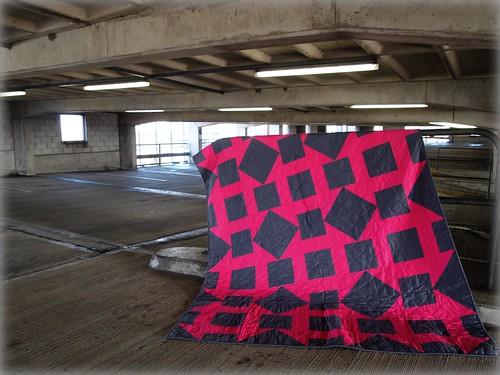
(80s Batwing Sweater,Katy Jones)
FQ - What do you want to achieve with Modern Day Quilts? (for example do you want to expand the minds of old fashioned quilters, bring unknown artists to the forefront, educate, rule the world...)
Modern quilting is evolving rapidly. I've been on the Fresh Modern Quilts flickr group since it was only a few dozen members. I want to capture the historical trends of modern quilting distilled, because that will be our definition as a community. It is fun to watch what becomes popular and trendy through the images. These trends don't always start with the big bloggers, I've seen someone do something really cool and then a bigger quilt blogger will tweak it, make a tutorial or popularize and it will take off. Ashley (Film in the Fridge) and her string quilts is a great example of this. She took that traditional block and owned it. Her string quilts also brought color into the forefront and made white the secondary color. Before that white was more heavily featured on quilts. On a color tangent, white used to be the major color element in modern quilts, but then grey has become huge. I'm going to go out on a limb and forecast to say that I think navy blue will be the next hot neutral/background in modern quilting.
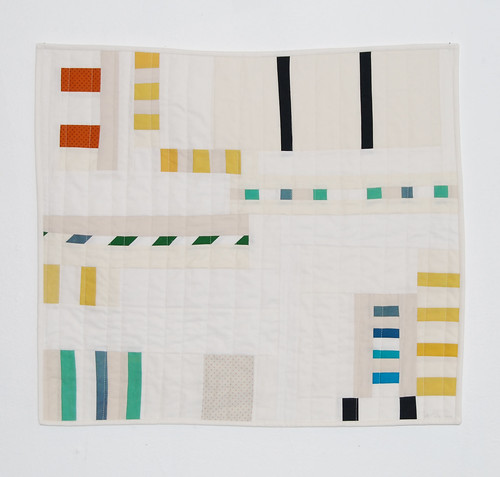
(Alliance by Alexia Abegg)
I'm not sure if "expand the minds of old fashion quilters" is the right term. Traditional quilters are light years ahead of modern quilters in many techniques. From a technical perspective, they do some really interesting stuff that modern quilters haven't touched. It just happens to be in layouts, color palettes and designs that are not appealing to modern quilters. Piping is a great example. It is very popular with traditionalists right now, but you don't see much of it in modern quilting. It is something that I really think, if used correctly, could be really amazing in modern quilting. An example of a technique developed by traditionalists but used by modernists is the 6-minute circle by Dale Fleming. I would qualify Dale Fleming as a traditionalist with art quilter influences. Her technique jumped the traditional/modern line and the modern quilt community has done some really amazing things with it. I think modern quilters have much to learn from traditionalists and vice versa. Sometimes we can be blinded only by the images in front of us and don't always look at the techniques behind it and how we can use that to our benefit. Personally, I think we are missing a big part of knowledge from the traditionalists.
I love featuring folks who only post their photos on flickr and don't have a blog. I feel like there is so much great talent out there, but not everyone has the time to blog. Quilts are a pretty large undertaking, quilting enough to keep up with a blog isn't always an option for everyone.
FQ - What does the future holds - how long do you think you can show a quilt a day? Are there that many quilts out there?
Sometimes I forget that modern quilting has not been online that long. I think the Fresh Modern Quilts group was started in late 2007, early 2008. That is not that long ago. Right now, it hasn't been to hard finding quilts. They majority of the quilts I've featured were made in the last few months. If needed, I will raid our brief past, but I'm trying to avoid that because I'd like to show what is happening in modern quilting today. Yet, I do think the past is important, I'm currently emailing a few quilt museums to see if I can feature photos from their collections. Some very modern looking quilts happen to be 100 years old. Poking around International Quilt Study Center & Museum's website is quite a bit of fun.
I've also got some ideas for monthly podcasts, which I'm mulling over in my head, but for right now, the blog is in a great place.
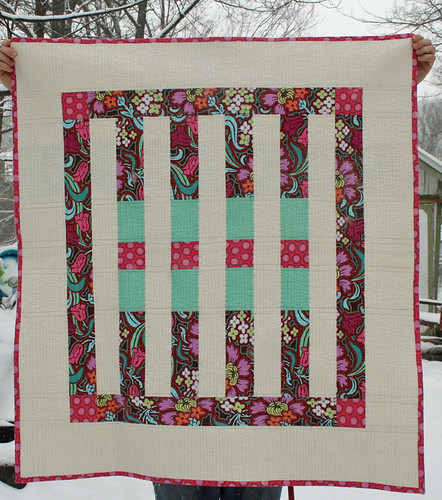
(Yield by Heather Jones)
FQ - Anything else you'd like to share?
I want to thank all the talented quilters out there, I am so happy quilting has progressed to such a fantastic viewpoint. I also want to thank R0ssie for birthing modern quilting. Denyse Schmidt and Yoshiko Jinzenji may have been the first artists, but by creating the flickr group in the beginning, she corralled all the online modern quilters into a community and she really defined modern quilting. Major props to her.
Major props to Heather too, we think. And a huge thank you for taking the time out to chat with us at FQ.












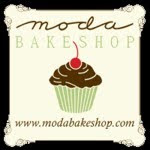











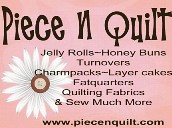








Heather, I love that you've given the modern quilters a place to gather and seek inspiration and challenge ...and a place for great eye candy!!! Love the quilts you feature!!!
ReplyDeleteHmmm, not sure I agree with Heather.
ReplyDeleteAnon - please share your thoughts on why. I am very curious to hear what other people have to say. It is only together as a community we can define modern quilting.
ReplyDeleteI hope we are not just replacing the word "older women" or "old style" or "traditional" with "modern"! Every generation puts it stamp on the art of the times, but... a quilt is still fabric layered over a filling... no matter the age or design of the quilt or quilter! The designs I see here have as much in common with the utility quilts of the Gee's Bend quilters as they do with historical quilts. I'm not sure that makes them revolutionary - or worthy of some sort of modern 'label'. Are we sure we are not just trying to create a "brand" to better appeal to a young and new (to quilt creation) demographic? - some thoughts that occurred as I read this. Love the improvisational quilt designs - however labeled!
ReplyDeleteI too, am a little turned off by this article. Heather has some nice ideas, particularly on tradtion, but I am befuddled by the need to "tighten up the definition of modern quilting." Why does Heather consider herself the authority on the subject? or, why does fat quarterly? I thought it was arrogant to say that she wanted to showcase "the best examples" of modern quilting today.
ReplyDeleteModern quilting has different definitions from one person to the next. That's the joy of being a "modern quilter." Perhaps all that modern means to one person is "no civil war reproduction fabrics" where as, to another person, it might just be an idea of experimenting with colour, prints, and scale. By tightening the definition, we take away the free flowing experimentation that is part of the "overwhelming" amount of modern quilting on Flickr or the quilting blogosphere.
I quite enjoyed Heather's article and don't like to get to caught up in labels. I like her choices and think it's wonderful that she wants to show case the work of modern quilters...no matter what their age....I don't think that's the point. I kind of get it, when she says she won't feature a quilt, that she wouldn't want in her house.
ReplyDeleteShe created the blog she wanted to read. I don't think anyone needs to feel defensive about that. If people want a more liberal definition of modern quilting, they're welcome to it - and vice versa, don't you think?
ReplyDelete